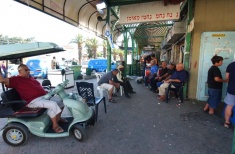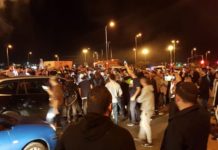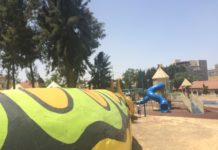
I explain that I had spent the morning in the areas that are now under attack in the Western Negev but had needed to be back in the centre of Sderot and that everything was ok. Although I could hear the worry in her voice that I had detected on numerous other occasions during and after events that I had covered in different parts of the world throughout my career so far, at least she would not have the added worry when she heard the latest news in a matter of minutes on the internet or television.
As I finished the call and turned to re-enter the office of the Sderot Media Centre where I had been based all week, the fake quiet of the previous nearly 7 days came to an abrupt halt as everyone knew that it would and the Tzeva Adom sounded.
Although hearing it for the first time and what my reaction to it would be had been foremost in my mind the whole time I was in Sderot, as is usual in these situations it was different to how I had envisaged it.
Firstly, it was not as loud as I had expected which was explained to me afterwards. Secondly, a question that I had asked the day before about 2 missiles coming in at the same time had been answered and thirdly, how quickly people had tried to continue with what they were doing as normally as possible under the circumstances directly after we had been attacked.
When the siren sounded, which is different to the sounds of the sirens during Yom Hashoah and Yom Hazikaron to mark the minute silence in memory of the Holocaust and Israel’s fallen soldiers, what you hear is a woman’s voice repeating the words Tzeva Adom (red alert). This is repeated clearly and calmly until the missile or missiles in this particular case had landed.
My first reaction was instinctive to an experienced photographer. I wanted to grab my cameras, run outside and capture pictures with personal safety coming second. However, most of the team from Sderot Media Centre who were inside the office when the siren sounded trying to gather information about the attacks which had just begun In the surrounding areas and get it on to the internet as quickly and accurately as possible, advised me that it was best to stay inside the office until the sirens stopped and we had heard the impact of the missiles. I was gratefully guided by their experience of thousands of sirens, missiles and years of experience living through these conditions.
Like most buildings in Sderot their offices do not have a shelter and although we could all see the nearest street shelter through the window on the other side of the road, even the fastest one of us could not have got there in 15 seconds so it was best to stay put and hope that we did not take a direct hit like many others have in the past 7 years.
We heard the impact of the first missile strike very closely, followed by a second loud thud. This had answered my previous days question as to how the siren system is able to alert people that a 2nd missile is on its way. As I had correctly been advised, it could not, so if people venture out when they think it is safe, the siren cannot cope with being able to warn of 2 missiles at the same time which was highlighted during this attack by it jamming.
As this was my first experience of Tzeva Adom the people I was working with thought it would be useful to capture my reactions on video which I thought was a very good idea in the ongoing battle within the media to show life from both sides of this conflict and not just the one that most of the media seem to be fooled by.
At this point what had struck me was seeing how quickly people tried to continue with what they had been doing just before the siren and get back to some kind of normality. Seeing a little girl continue her journey home from school like any child anywhere else in the world was surreal for me after witnessing first hand what had just happened.
On this occasion the people of Sderot had been quite lucky physically, as the missiles had exploded in open fields just outside of town which explained why the sirens where we had been were not as loud as I had expected. The reason for this is that Sderot is split into sections for the purpose of alerting its residents of the closeness of where the missile is heading to their section. If they hear the siren very clearly, it means that they are very close to where the Qassam will land. If the siren is not so loud, as in our case, it means it will land in a different part of town. However this is mental torture for people who have to deal with this everyday of their lives and why so many of them have been so badly traumatised.
My main objectives had now been achieved. I had wanted to see for myself firstly in a personal capacity as a new immigrant to Israel what life was like for the people of Sderot and the Western Negev. Not as someone going there on a day trip or watching it on a 30 second segment on the evening news or seeing a picture of a roof with a big hole in it. But as someone actually living there for a short time, getting to know people, hearing their stories and seeing the conditions they are forced to live under. And secondly as someone who understands from years of experience how the media works and wanting and trying to portray the real story of the human side of this tragedy which is being allowed to continue.
It’s not often that returning back to Jerusalem feels like getting back to normality. Anyone who has ever spent time here could hardly call this amazing place, often referred to as the most disputed piece of real estate in the world, and the place where the final battle between Gog & Magog is supposed to take place, normal. However after 5 days in Sderot, arriving back in Jerusalem after the 60 minute bus journey and not having to look for the nearest shelter or react to every loud noise, to be able to sit at an outdoor café and bring in Shabbat without the fear of a Tzeva Adom at any time, makes you see things in a very different light.
Reflecting on the experience that I have been through over the past week, I do not recall one conversation about the current political situation while in Sderot This is very unusual here as everywhere you go normally there is an argument going on between people with different opinions on everything. How they know what is best for the country and what they would do if they were Prime Minister. The only time I heard anything mentioned about the government was when I asked a resident if they felt they had been let down by the people leading our country to which the response was that up until disengagement they did not feel let down but since, they feel very let down, which they have good reason to.
Personally, the feeling that I left with from Sderot was that the people who remain there, some through choice but most without, seem to have the spirit and faith that was what originally built this country. This feeling seems to have been forgotten by a large amount of people who do not seem to understand that, although right now it is not them and their families having to endure this on a daily basis, if things are allowed to continue the way they are and our leaders are more interested in their own political survival than the security of the state of Israel that is so essential to the survival of the Jewish people, they soon will.
According to the Intelligence and Information Centre, approximately 45,000 residents in the Western Negev, including Sderot and other numerous Kibbutzim and Moshavim, have been living under daily rocket terror. In the year 2008, the number of Israelis living under rocket threat will have increased to 250,000 according to Israeli Internal Security Minister, Avi Dichter. Heavily populated cities like Ashkelon, Netivot, Ofakim, and the inland city of Kiryat Gat will also be subject to rocket attack, once Palestinian terror groups begin launching long-range Katuysha rockets.
As Noam Bedein explained to me. “These rockets are aimed at us, Jews and Israelis alike. At this time they are aimed towards Sderot residents, with intent to kill and traumatise as many civilians as possible. Sderot is the only town in the entire western world, where rockets are being fired daily at a civilian population and yet there is no public outcry. Sderot is a reflection of us, the Israeli public, the Jewish world as well as the Western free world. What needs to be heard is outrage, indignation, condemnation and outright action for what has been happening over the past 3 years in Sderot and the Western Negev. In a few years, Sderot will be the test case of how the free world has reacted to this intolerable situation.”











